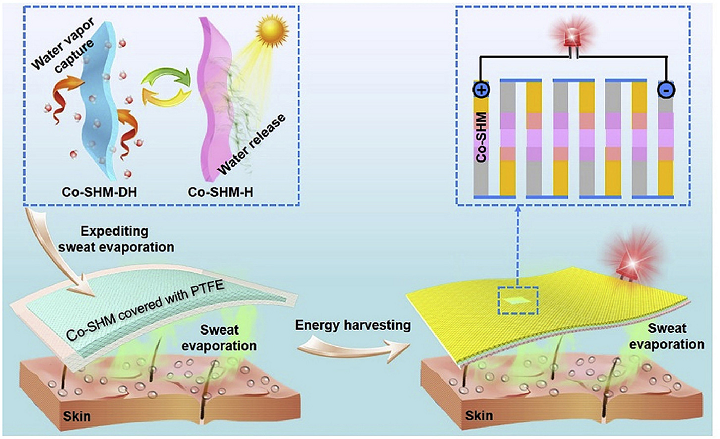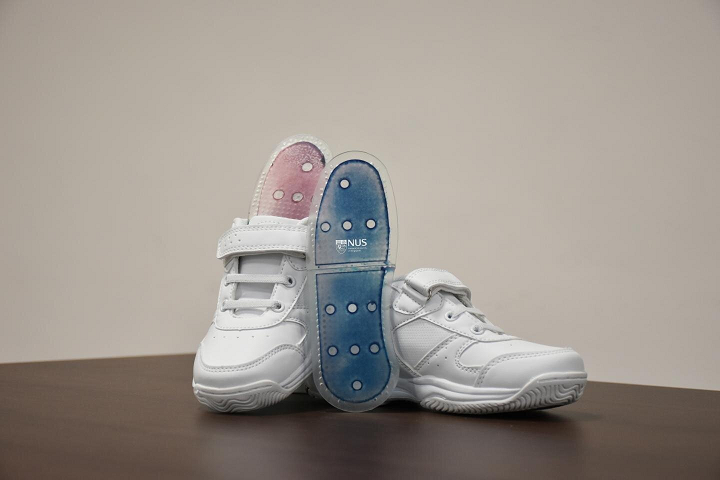Sweating is not really pleasant, but it’s a normal, natural way for the human body to regulate body temperature by decreasing thermal stress, which can occur for a number of reasons, including exercising, high temperatures, eating spicy food, or when you’re experiencing anxiety or embarrassment. Researchers from the National University of Singapore (NUS) created a novel film that can evaporate sweat six times faster and use the harvested moisture to power wearable electronic devices. They recently published a paper about their work, titled “Super-hygroscopic film for wearables with dual functions of expediting sweat evaporation and energy harvesting,” in the scientific journal Nano Energy, and 3D printed a prototype product for what seems to be a very helpful application.
The abstract states, “Despite the boom in atmospheric water-harvesting techniques, few attempts have been made with a broader horizon–absorbing the moisture from sweatevaporation, which has substantial implications for human comfort and wearable electronics. Herein, a cobalt-complex-based super-hygroscopic material (Co-SHM) is developed to expedite sweat evaporation and fabricate moisture-triggered energy harvesting devices. The Co-SHM features transparent thin-film structure, fast absorption kinetics and high water uptake of 4.6 g g−1. The material regeneration can be driven by natural sunlight, making the Co-SHM an energy-efficient moisture absorbent. Integrating the Co-SHM into breathable and waterproof PTFE membranes, we design new kinds of armpit pad, shoe lining, and insole, which can rapidly absorb the moisture from sweat to prevent sweat accumulation, thereby providing a dry and comfortable microclimate for people. Furthermore, the absorbed sweat can be transduced to energy through a Co-SHM based wearable energy harvesting devices.”

A cobalt-complex-based super-hygroscopic material (Co-SHM) that can rapidly and reversibly absorb moisture while using the natural sunlight for material regeneration has been developed. Integrating the Co-SHM into wearables can expedite sweat evaporation and construct wearable energy harvesting device.
The authors of the research paper are Xueping Zhang, Jiachen Yang, Ramadan Borayek, Hao Qu, Dilip Krishna Nandakumar, Qian Zhang, Jun Ding, Swee Ching Tan, all from the university’s Department of Materials Science and Engineering.
“Sweat is mostly composed of water. When water is evaporated from the skin surface, it lowers the skin temperature and we feel cooler,” explained research team leader Assistant Professor Tan Swee Ching. “In our new nvention, we created a novel film that is extremely effective in evaporating sweat from our skin and then absorbing the moisture from sweat. We also take this one step further—by converting the moisture from sweat into energy that could be used to power small wearable devices.”
The novel film is made of the hygroscopic (moisture-absorbing) chemicals cobalt chloride and ethanolamine. Most hygroscopic materials, like silica gels or zeolites, feature bulk solid structures and low water uptake, which means they’re not ideal for absorbing the moisture from evaporating sweat. But the NUS team’s film can reportedly take in 15 times more moisture than these other hygroscopic materials, and when it’s exposed to sunlight, it can release the water very rapidly. In addition, the film changes color from blue to purple and then pink when it absorbs the moisture, which is a pretty nifty way to tell just how much moisture has been absorbed. Finally, the film can actually be regenerated when placed in sunlight, and reused over 100 times, which is great news on the sustainability front.

An NUS research team led by Assistant Professor Tan Swee Ching (seated, left) and Professor Ding Jun (seated, right) developed a novel film that is extremely effective in evaporating sweat from our skin. Promising applications include shoe insoles and linings, as well as underarm pads for sweat absorption.
In a proof of concept demonstration, the researchers designed a wearable device that uses the film as an electrolyte and harvests enough energy from the absorbed moisture to power a light-emitting diode, without the use of any batteries. Each of the eight electrochemical cells (ECs) that make up the device can generate about 0.57 volts of electricity.
The team also demonstrated how their novel moisture-absorbing film could be used to help with some of the common problems that arise from heavy sweating. They packaged their novel film into waterproof, breathable polytetrafluoroethylene (PTFE) membranes, which are often used in clothing due to their flexibility. Then, these membranes were used as a prototype underarm pad, as well as the prototype lining and insoles for a shoe.
“The prototype for the shoe insole was created using 3-D printing,” explained research team co-leader Professor Ding Jun. “The material used is a mixture of soft polymer and hard polymer, thus providing sufficient support and shock absorption.”
We’ve definitely seen 3D printing used to fabricate shoe insoles before, so there’s a real possibility that this could one day be a commercially available item.

A team of NUS researchers invented a novel thin film that evaporates sweat six times faster and holds 15 times more moisture than conventional materials. In this prototype, the insole coated with the film turns from blue to pink as it absorbs moisture. The insole can be easily ‘regenerated’ by putting it under the sun, and be reused for more than 100 times.
“Underarm sweating is embarrassing and frustrating, and this condition contributes to the growth of bacteria and leads to unpleasant body odor,” said Assistant Professor Tan. “Accumulation of perspiration in the shoes could give rise to health problems such as blisters, calluses, and fungal infections. Using the underarm pad, shoe lining and shoe insole embedded with the moisture-absorbing film, the moisture from sweat evaporation is rapidly taken in, preventing an accumulation of sweat and provides a dry and cool microclimate for personal comfort.”
The next step for the NUS researchers and their novel moisture-absorption film is to work with companies that might allow them to add the film into consumer products.
(Source: Phys.org / Images: National University of Singapore)
Subscribe to Our Email Newsletter
Stay up-to-date on all the latest news from the 3D printing industry and receive information and offers from third party vendors.
You May Also Like
Further Understanding of 3D Printing Design at ADDITIV Design World
ADDITIV is back once again! This time, the virtual platform for additive manufacturing will be holding the first-ever edition of ADDITIV Design World on May 23rd from 9:00 AM –...
3D Printer Maker EVO-tech Reborn as NEVO3D — Once More With Feeling
EVO-tech was a 3D printing service and original equipment manufacturer established in 2013 and based in Schörfling am Attersee, Austria. The company produced high-quality material extrusion systems featuring linear bearings,...
3D Systems Brings 3D Printed PEEK Cranial Implant to the U.S. with FDA Clearance
For more than 10 years, 3D Systems (NYSE:DDD) has worked hand-in-hand with surgeons to plan over 150,000 patient-specific cases, and develop more than two million instruments and implants from its...
CDFAM Returns to Berlin for Second Annual Symposium
The second CDFAM Computational Design Symposium is scheduled for May 7-8, 2024, in Berlin, and will convene leading experts in computational design across all scales. Building upon the first event...































